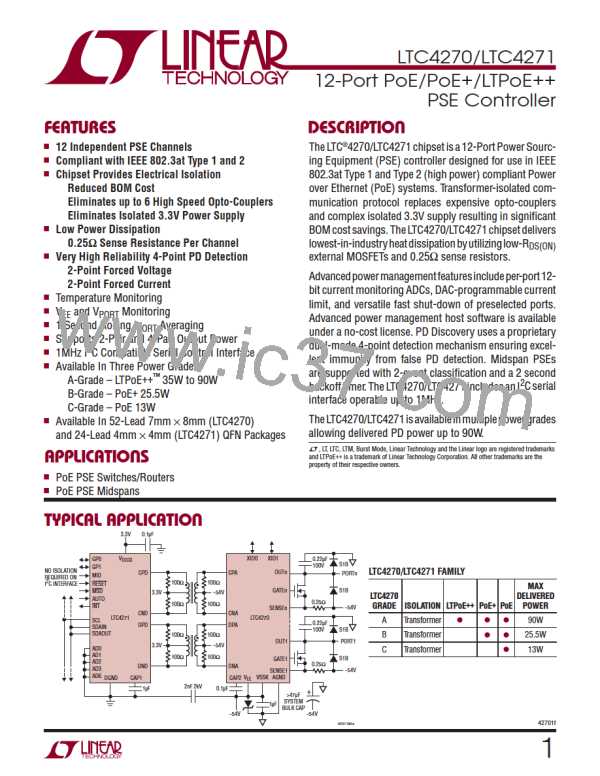LTC4270/LTC4271
APPLICATIONS INFORMATION
the classification signature current (in this case, Class 3)
802.3at 2-Event Classification
in the V
range. Table 4 shows the possible clas-
CLASS
sification values.
The802.3atspecificationdefinestwomethodsofclassify-
ing a Type 2 PD. A-grade and B-grade LTC4270/LTC4271
parts support 802.3at 2-event classification.
Table 4. 802.3af and 802.3at Classification Values
CLASS
Class 0
Class 1
Class 2
Class 3
Class 4
RESULT
One method adds extra fields to the Ethernet LLDP data
protocol; although the LTC4270/LTC4271 is compatible
with this classification method, it cannot perform clas-
sification directly since it doesn’t have access to the data
path. LLDP classification requires the PSE to power the
PD as a standard 802.3af (Type 1) device. It then waits for
the host to perform LLDP communication with the PD and
updatethePSEportdata. TheLTC4270/LTC4271supports
No Class Signature Present; Treat Like Class 3
3W
7W
13W
25.5W (Type 2)
If classification is enabled, the port will classify the PD
immediatelyafterasuccessfuldetectioncycleinsemi-auto
or AUTO pin modes, or when commanded to in manual
mode. It measures the PD classification signature by ap-
plying 18V for 12ms (both values typical) to the port via
the OUTn pin and measuring the resulting current; it then
reports the discovered class in the Port Status register.
If the LTC4270/LTC4271 is in AUTO pin mode, it will ad-
changing the I
and I
levels on the fly, allowing the
LIM
CUT
host to complete LLDP classification.
The second 802.3at classification method, known as
2-event classification or ping-pong, is supported by
the LTC4270/LTC4271. A Type 2 PD that is requesting
more than 13W will indicate Class 4 during normal
802.3af classification. If the LTC4270/LTC4271 sees
Class 4, it forces the port to a specified lower voltage
(called the mark voltage, typically 9V), pauses briefly, and
then re-runs classification to verify the Class 4 reading
(Figure1).ItalsosetsabitintheHighPowerStatusregister
to indicate that it ran the second classification cycle. The
second cycle alerts the PD that it is connected to a Type
2 PSE which can supply Type 2 power levels.
ditionally use the classification result to set the I
and
CUT
I
thresholds. See the Reset and the AUTO/MID Pin
LIM
section for more information.
The classification circuitry is disabled when the port is
initially powered up with the AUTO pin low, in shutdown
mode,orwhenthecorrespondingClassEnablebitiscleared.
60
PSE LOAD LINE
OVER
CURRENT
50
2-event ping-pong classification is enabled by setting a bit
in the port’s High Power Mode register. Note that a ping-
pongenabledportonlyrunsthesecondclassificationcycle
when it detects a Class 4 device; if the first cycle returns
Class 0 to 3, the port determines it is connected to a Type 1
PD and does not run the second classification cycle.
48mA
40
30
20
10
0
CLASS 4
CLASS 3
33mA
23mA
CLASS 2
TYPICAL
CLASS 3
PD LOAD
LINE
14.5mA
6.5mA
CLASS 1
CLASS 0
Invalid Type 2 Class Combinations
The 802.3at specification defines a Type 2 PD class signa-
ture as two consecutive Class 4 results; a Class 4 followed
by a Class 0-3 is not a valid signature. In AUTO pin mode,
theLTC4270/LTC4271willpoweradetectedPDregardless
of the classification results, with one exception: if the PD
presents an invalid Type 2 signature (Class 4 followed by
Class0to3), theLTC4270/LTC4271willnotprovidepower
and will restart the detection process. To aid in diagnosis,
0
5
10
15
20
25
VOLTAGE (V
)
CLASS
42701 F13
Figure 13. PD Classification
42701f
21

 Linear [ Linear ]
Linear [ Linear ]